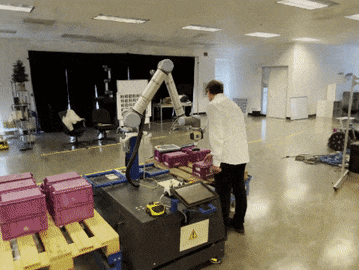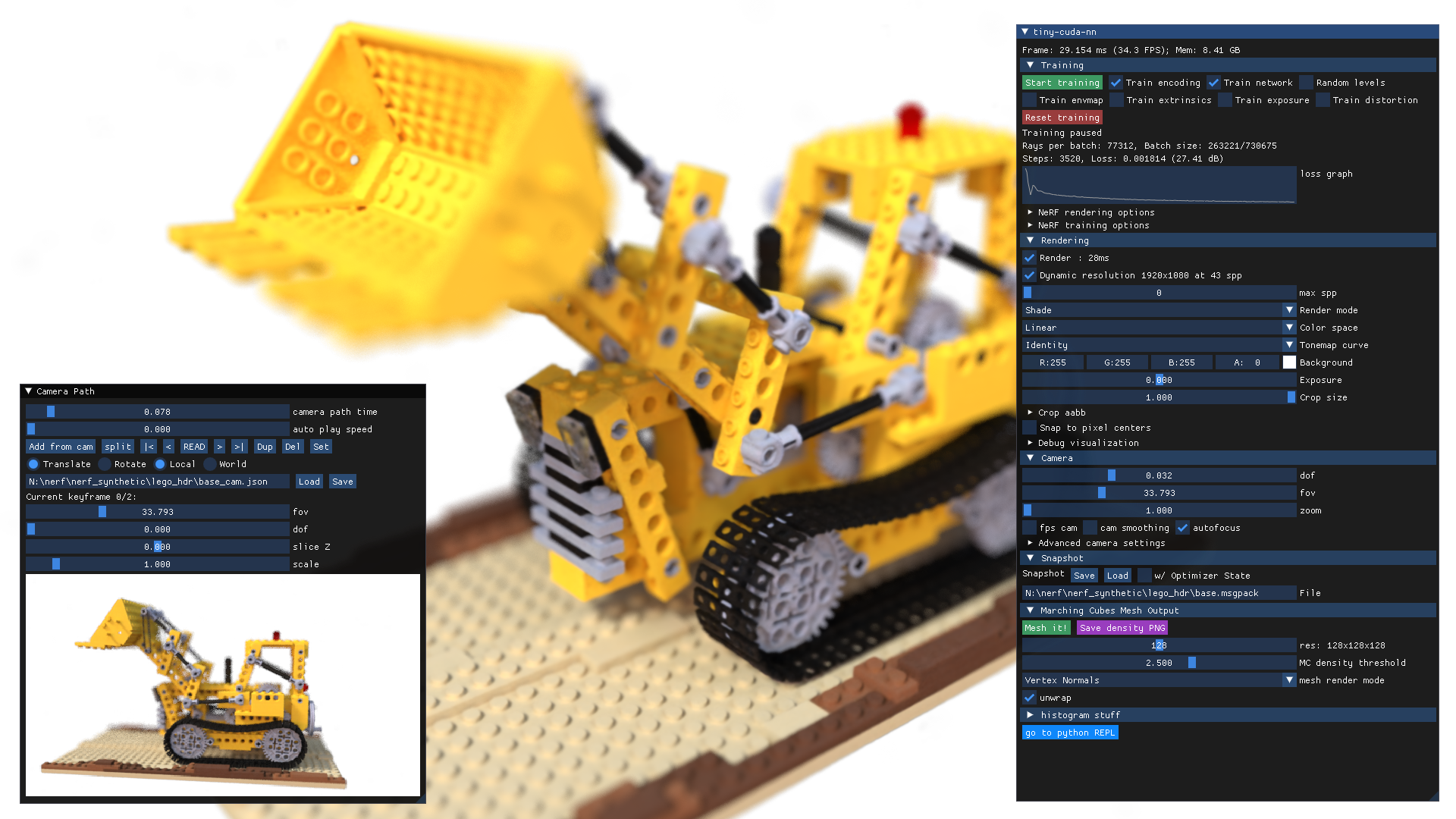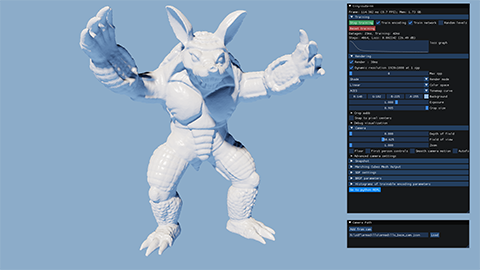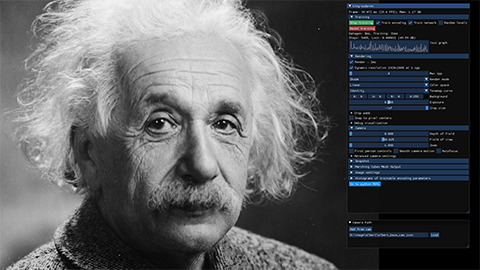Ever wanted to train a NeRF model of a fox in under 5 seconds? Or fly around a scene captured from photos of a factory robot? Of course you have!
Here you will find an implementation of four neural graphics primitives, being neural radiance fields (NeRF), signed distance functions (SDFs), neural images, and neural volumes. In each case, we train and render a MLP with multiresolution hash input encoding using the tiny-cuda-nn framework.
Instant Neural Graphics Primitives with a Multiresolution Hash Encoding
Thomas Müller, Alex Evans, Christoph Schied, Alexander Keller
arXiv:2201.05989 [cs.CV], Jan 2022
[ Project page ] [ Paper ] [ Video ] [ BibTeX ]
For business inquiries, please visit our website and submit the form: NVIDIA Research Licensing
- An NVIDIA GPU; tensor cores increase performance when available. All shown results come from an RTX 3090.
- A C++14 capable compiler. The following choices are recommended and have been tested:
- Windows: Visual Studio 2019
- Linux: GCC/G++ 7.5 or higher
- CUDA v10.2 or higher and CMake v3.19 or higher.
- (optional) Python 3.7 or higher for interactive bindings. Also, run
pip install -r requirements.txt.- On some machines,
pyexrrefuses to install viapip. This can be resolved by installing OpenEXR from here.
- On some machines,
- (optional) OptiX 7.3 or higher for faster mesh SDF training. Set the environment variable
OptiX_INSTALL_DIRto the installation directory if it is not discovered automatically.
If you are using Linux, install the following packages
sudo apt-get install build-essential git python3-dev python3-pip libopenexr-dev libxi-dev \
libglfw3-dev libglew-dev libomp-dev libxinerama-dev libxcursor-devWe also recommend installing CUDA and OptiX in /usr/local/ and adding the CUDA installation to your PATH.
For example, if you have CUDA 11.4, add the following to your ~/.bashrc
export PATH="/usr/local/cuda-11.4/bin:$PATH"
export LD_LIBRARY_PATH="/usr/local/cuda-11.4/lib64:$LD_LIBRARY_PATH"Begin by cloning this repository and all its submodules using the following command:
$ git clone --recursive https://github.com/nvlabs/instant-ngp
$ cd instant-ngpThen, use CMake to build the project: (on Windows, this must be in a developer command prompt)
instant-ngp$ cmake . -B build
instant-ngp$ cmake --build build --config RelWithDebInfo -j 16If the build fails, please consult this list of possible fixes before opening an issue.
If the build succeeds, you can now run the code via the build/testbed executable or the scripts/run.py script described below.
If automatic GPU architecture detection fails, (as can happen if you have multiple GPUs installed), set the TCNN_CUDA_ARCHITECTURES enivonment variable for the GPU you would like to use. The following table lists the values for common GPUs. If your GPU is not listed, consult this exhaustive list.
| RTX 30X0 | A100 | RTX 20X0 | TITAN V / V100 | GTX 10X0 / TITAN Xp | GTX 9X0 | K80 |
|---|---|---|---|---|---|---|
| 86 | 80 | 75 | 70 | 61 | 52 | 37 |
This codebase comes with an interactive testbed that includes many features beyond our academic publication:
- Additional training features, such as extrinsics and intrinsics optimization.
- Marching cubes for
NeRF->MeshandSDF->Meshconversion. - A spline-based camera path editor to create videos.
- Debug visualizations of the activations of every neuron input and output.
- And many more task-specific settings.
- See also our one minute demonstration video of the tool.
One test scene is provided in this repository, using a small number of frames from a casually captured phone video:
instant-ngp$ ./build/testbed --scene data/nerf/foxAlternatively, download any NeRF-compatible scene (e.g. from the NeRF authors' drive). Now you can run:
instant-ngp$ ./build/testbed --scene data/nerf_synthetic/lego/transforms_train.jsonFor more information about preparing datasets for use with our NeRF implementation, please see this document.
instant-ngp$ ./build/testbed --scene data/sdf/armadillo.objinstant-ngp$ ./build/testbed --scene data/image/albert.exrTo reproduce the gigapixel results, download, for example, the Tokyo image and convert it to .bin using the scripts/image2bin.py script. This custom format improves compatibility and loading speed when resolution is high. Now you can run:
instant-ngp$ ./build/testbed --scene data/image/tokyo.binDownload the nanovdb volume for the Disney cloud, which is derived from here (CC BY-SA 3.0).
instant-ngp$ ./build/testbed --mode volume --scene data/volume/wdas_cloud_quarter.nvdbTo conduct controlled experiments in an automated fashion, all features from the interactive testbed (and more!) have Python bindings that can be easily instrumented.
For an example of how the ./build/testbed application can be implemented and extended from within Python, see ./scripts/run.py, which supports a superset of the command line arguments that ./build/testbed does.
Happy hacking!
Before investigating further, make sure all submodules are up-to-date and try compiling again.
instant-ngp$ git submodule sync --recursive
instant-ngp$ git submodule update --init --recursiveIf instant-ngp still fails to compile, update CUDA as well as your compiler to the latest versions you can install on your system. It is crucial that you update both, as newer CUDA versions are not always compatible with earlier compilers and vice versa. If your problem persists, consult the following table of known issues.
| Problem | Resolution |
|---|---|
| CMake error: No CUDA toolset found / CUDA_ARCHITECTURES is empty for target "cmTC_0c70f" | Windows: the Visual Studio CUDA integration was not installed correctly. Follow these instructions to fix the problem without re-installing CUDA. (#18) |
Linux: Environment variables for your CUDA installation are probably incorrectly set. You may work around the issue using cmake . -B build -DCMAKE_CUDA_COMPILER=/usr/local/cuda-<your cuda version>/bin/nvcc (#28) |
|
| CMake error: No known features for CXX compiler "MSVC" | Reinstall Visual Studio & make sure you run CMake from a developer shell. (#21) |
| Compile error: undefined references to "cudaGraphExecUpdate" / identifier "cublasSetWorkspace" is undefined | Update your CUDA installation (which is likely 11.0) to 11.3 or higher. (#34 #41 #42) |
| Compile error: too few arguments in function call | Update submodules with the above two git commands. (#37 #52) |
| Python error: No module named 'pyngp' | It is likely that CMake did not detect your Python installation and therefore did not build pyngp. Check CMake logs to verify this. If pyngp was built in a different folder than instant-ngp/build, Python will be unable to detect it and you have to supply the full path to the import statement. (#43) |
If you cannot find your problem in the table, please feel free to open an issue and ask for help.
Many thanks to Jonathan Tremblay and Andrew Tao for testing early versions of this codebase and to Arman Toorians and Saurabh Jain for the factory robot dataset. We also thank Andrew Webb for noticing that one of the prime numbers in the spatial hash was not actually prime; this has been fixed since.
This project makes use of a number of awesome open source libraries, including:
- tiny-cuda-nn for fast CUDA MLP networks
- tinyexr for EXR format support
- tinyobjloader for OBJ format support
- stb_image for PNG and JPEG support
- Dear ImGui an excellent immediate mode GUI library
- Eigen a C++ template library for linear algebra
- pybind11 for seamless C++ / Python interop
- and others! See the
dependenciesfolder.
Many thanks to the authors of these brilliant projects!
@article{mueller2022instant,
title = {Instant Neural Graphics Primitives with a Multiresolution Hash Encoding},
author = {Thomas M\"uller and Alex Evans and Christoph Schied and Alexander Keller},
journal = {arXiv:2201.05989},
year = {2022},
month = jan
}Copyright © 2022, NVIDIA Corporation. All rights reserved.
This work is made available under the Nvidia Source Code License-NC. Click here to view a copy of this license.






